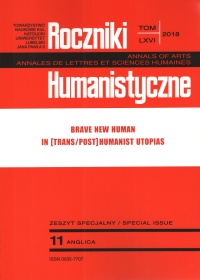Paradoxes of Transrobotism: an Anti-Transhumanist Reading of Chris Columbus’s Bicentennial Man
Abstract
This essay proposes a re-reading of Chris Columbus’s film Bicentennial Man (1999) as a critique of transhumanism. Construing the robot protagonist, Andrew Martin, as a metaphor of the human being, the essay argues that the series of modifications he undergoes is a reversed version, as it were, of transformations postulated in Nick Bostrom’s “Letter from Utopia” and the Transhumanist Declaration—the famous manifestos of transhumanism. Consequently, the film is interpreted as an affirmation of humanity defined by conservative opponents of transhumanism.
References
Anderson, Susan Leigh. “Asimov’s ‘Three Laws of Robotics’ and Machine Metaethics.” AI & Society 22 (2008): 477–493. Print.
Asimov, Isaac and Robert Silverberg. The Positronic Man. New York: Doubleday, 1993. EPUB file.
Asimov, Isaac. “The Bicentennial Man.” The Bicentennial Man and Other Stories. New York: Doubleday, 1976. EPUB file.
Bicentennial Man. Dir. Chris Columbus. Buena Vista Pictures, 1999. DVD.
Bostrom, Nick. “Letter From Utopia.” Web.
Bostrom, Nick. “Why I Want to be a Posthuman When I Grow Up.” The Transhumanist Reader. Ed. Max More and Natasha Vita-More. Oxford: Wiley-Blackwell, 2013. 28–53. Print.
Buckner Inniss, Lolita K. “Bicentennial Man - The New Millennium Assimilationism and the Foreigner among Us.” Rutgers Law Review 54 (2002): 1101–1132. Print.
Clevenger, Scott and Sheri Zollinger. Better Living through Bad Movies. Lincoln: iUniverse, 2006. Print.
Coleman, Stephen and Richard Hanley. “Homo Sapiens, Robots, and Persons in I, Robot and Bicentennial Man.” Bioethics in the Movies. Ed. Sandra Shapshay. Baltimore: The Johns Hopkins University Press, 2009. 44–55. Print.
D’Ammassa, Don. Encyclopedia of Science Fiction. New York: Facts On File, 2005. Print.
Dmitruk, Natalia. “Are You Really a Child? Androids and Cyborgs in Japanese Comics and Animations.” Androids, Cyborgs, and Robots in Contemporary Culture and Society. Ed. Steven John Thompson. Hershey: IGI Global: 2017. 65–95. Print.
Falzon, Christopher. Philosophy Goes to the Movies: An Introduction to Philosophy. London: Routledge, 2002. Print.
Fukuyama, Francis. Our Posthuman Future: Consequences of the Biotechnology Revolution. New York: Farrar, Straus and Giroux, 2002. Print.
Higgins, Mike. “Bicentennial Man reviewed by Mike Higgins.” Web.
Kakoudaki, Despina. Anatomy of a Robot: Literature, Cinema, and the Cultural Work of Artificial People. New Brunswick: Rutgers University Press, 2014. Print.
Konefał, Sebastian Jakub. Corpus Futuri: Literackie i filmowe wizerunki postludzi. Gdańsk: Wydawnictwo Uniwersytetu Gdańskiego, 2013. Print.
Kowalski, Dean A. Classic Questions and Contemporary Film: An Introduction to Philosophy, 2nd ed. Chichester: Wiley Blackwell, 2016. Print.
Kwiatkowski, Fryderyk. “‘Let Us Make ROBOT in Our Image, According to Our Likeness’: An Examination of Robots in Several Science Fiction Films through the Christian Concept of the ‘Image of God’.” Studia Religiologica 49.3 (2016): 219–230. Print.
Mann, George, ed. The Mammoth Encyclopedia of Science Fiction. London: Robinson Publishing, 2001. Print.
More, Max. “The Philosophy of Transhumanism.” The Transhumanist Reader. Ed. Max More and Natasha Vita-More. Oxford: Wiley-Blackwell, 2013. 3–17. Print.
Porter, Edward. “Bicentennial Man.” The Sunday Times, 23 January 2000. EBSCOhost. Web.
Radkowska-Walkowicz, Magdalena. Od Golema do Terminatora: Wizerunki sztucznego człowieka w kulturze. Warszawa: Wydawnictwa Akademickie i Profesjonalne, 2008. Print.
Schwarzbaum, Lisa. “Movies.” Entertainment Weekly 520. 7 January 2000: 46. EBSCOhost Web.
Short, Sue. “The Measure of a Man?: Asimov’s Bicentennial Man, Star Trek’s Data, and Being Human.” Extrapolation 44.2 (2003): 209–223. Print.
Tookey, Christopher. Named & Shamed: The World’s Worst and Wittiest Movie Reviews, from Affleck to Zeta-Jones. Matador, 2010. Print.
“Transhumanist Declaration.” H+pedia. 2 January 2016. Web.
Copyright (c) 2018 Roczniki Humanistyczne

This work is licensed under a Creative Commons Attribution-NonCommercial-NoDerivatives 4.0 International License.





